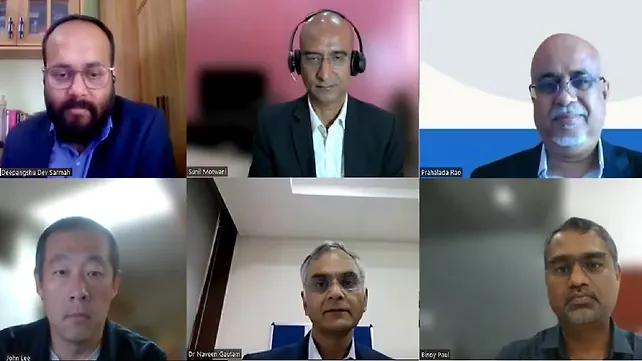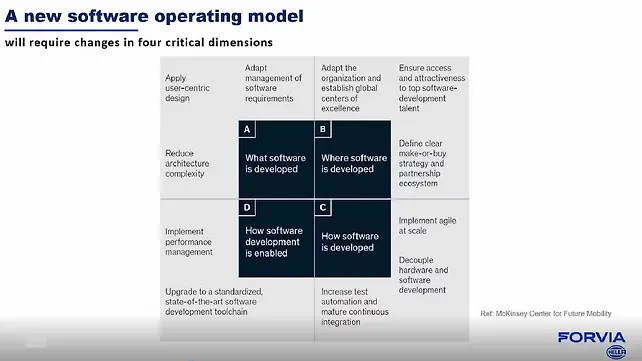
Software, as is evident from Mahindra’s recent launches – the XUV700 and Scorpio N, for example – is going to dominate the vehicles of the future.
As a matter of fact, software defined vehicles will make sure that revenue streams for OEMs continue beyond vehicle sales. However, the EE architecture will need to keep pace with the rapidly changing needs of the consumer. The same will only be possible if the vehicle architecture supports this analogy. Centralisation of software will also be necessary as the same will help reduce the number of ECUs, and hence complexity.
“Agile and DevOps will be the right approach. The product does not stop at SOP. A product's life starts at SOP. OEMs will have to move towards central compute and adapt micro service architecture,” explained Binoy Paul, Vice President – Automotive (Farm Equipment and Agri Business), Mahindra & Mahindra during a recent roundtable organised by Mobility Outlook on “Upshifting to the Next-Gen Software Defined Vehicle”, powered by MathWorks.
Paul was part of a stellar group of experts from the industry, including Dr Naveen Gautam, MD, Hella India Automotive; Prahalada Rao, President & Client Partner, Tata Technologies and John Lee, Senior Consulting Manager, MathWorks, who participated in the virtual discussion.
Earlier, while welcoming the speakers, Deepangshu Dev Sarmah, Editor, Mobility Outlook said software will become the critical tipping point in the auto industry, while OEMs and Tier-1 suppliers look to capture business in this software-driven value chain. “It is not for nothing that manufacturers and suppliers globally are vigorously expanding their internal software R&D teams to reduce the cost of software outsourcing,” he said.
The evolution of software in the automobile vertical can be gauged from the fact that there are more codes running in a passenger car than in an aircraft, highlighted Sunil Motwani, Country Manager – Sales & Service, MathWorks India.
“Software is becoming an integral part of the vehicles. We have tens and millions of codes running in today's vehicles. The future vehicles are going to be software that defines the user experience,” said Motwani.
India No More A Follower Market
While electrification, automation and shared mobility are the trends enabling adoption of more and more codes in vehicles, the focus of new-age software has been on making vehicles safer and more convenient to use for consumers. In numbers, the global automotive software market size, as per Markets & Markets, is expected to grow at the CAGR of 13.1% from $21.7 billion in 2022 to $40.1 billion by 2027. Compliance towards fuel efficiency standards, comfort, convenience, and need for reducing vehicle downtime will drive the market for automotive software.
Software, which used to be a small piece in the automobile puzzle some 20 years ago, has emerged as the driving force of vehicles today, noted Paul. “Growth of software in vehicles is such a great opportunity. India is no more just a follower market, when it comes to trends in the automobile vertical,” he said.
Value vs Complexity Factor
The automotive OEMs, as is the need of the hour, will have to invest heavily in software development as the software defined vehicles is not just an engineering topic, but an organisational topic. Strategic partnerships between the right set of organisations have become crucial to stay afloat in the market. Start-ups, working on software IP, as per Paul, will be an equally important part of the equation for OEMs and component makers.
Dr Gautam argued that OEMs and Tier 1 suppliers trying to do a lot of things will increase software complexity. A new software operating model will require changes in critical dimensions including where the software is being developed and how software is being developed. “The value addition happening compared to the level of complexity that we are increasing is a factor of four,” he said.
A need to establish responsibility to who owns what in the ecosystem might help in decreasing this complexity. The old-school sourcing model for OEMs worked around paying for hardware as the software came bundled free. The same model is not going to work in the software defined vehicles as the software and feature content is significantly increasing. OEMs and suppliers need to define the layers of software they are responsible for.
“Everyone in the chain must know what change they are making. They must also make sure to pass on minimum changes to the next layer,” explained Dr Gautam. Blending legacy machines and modern-age components might get difficult for OEMs as the software part starts defining more and more about the vehicles of today.
Cloud services will have a larger role to play in helping solve the complexities arising out of the increased software part in vehicles. Calculations in cloud, as noted by Rao, will not just revolve around solving these complexities but they will also play a role in every part of an automobiles lifecycle, starting from design to manufacturing to retail to after-sales services.
Rao said, “I think cloud will become more core to OEM's thinking. The entire sales and service operations will change significantly.”
As the list of features inside an automobile increases, the focus of the end-consumer might get more inclined towards experiencing and enjoying them, and less towards safety and security. Lee is of the view that the security and safety of the consumer sitting in a car loaded with software is the biggest responsibility of software developers and OEMs.

Lee said, “Making sure that vehicles are safe and secure will require a lot of validation. This is where organisations like MathWorks come into the picture. We can help OEMs with tools required to test, validate solutions and implement the same in a safe way inside a vehicle.”
However, hiring thousands of software engineers will not mean that it will become easier for an automobile OEM to transition to a software OEM. Things will become more complex as electric and more alternate fuels (like hydrogen) become more mainstream. Codes that work with ICE vehicles might simply develop glitches in electric, hybrid or hydrogen vehicles. While standardisation could be an answer for addressing the complexity, it is not as easy as it is in many other industries.
“Drivetrain transitions will continue but software as an enabling factor for customer experience will remain constant. Standardisation is happening in the automotive industry. It is not easy as it is in any other industry but it is possible, and it is happening. It's all about API definitions,” noted Paul.
Customer Centric Thinking
The future car, or the software defined car, will only be able to attract consumers when the OEMs, suppliers, and the software teams develop customer centric solutions. As a matter of fact, consumer centric features enabled by software, will help create the best of partnerships in the automotive vertical in the future.
“Electronics and software will be the major reasons for future collaborations and acquisitions in the automotive industry,” highlighted Dr Gautam.
In Conclusion
Consumers, 10 years from now, might not care if he is driving an EV, an ICE or a hydrogen vehicle. However, he will definitely care about the type and number of features being offered in a vehicle by the OEM. Then would arise the problem of deploying mobile centric apps in auto vehicles and the same will force the software teams working for an OEM to come up with new frameworks for already existing apps.
Paul questioned, “Today we are talking about ICE to EV transformation. But what after EV? By 2030, we might get features in a car the same as we get in our homes.”
Dr Gautam added, “People, by 2030, might not care about who or what is driving a car. They will be busy carrying on their living room activities to people moving rooms (cars).”